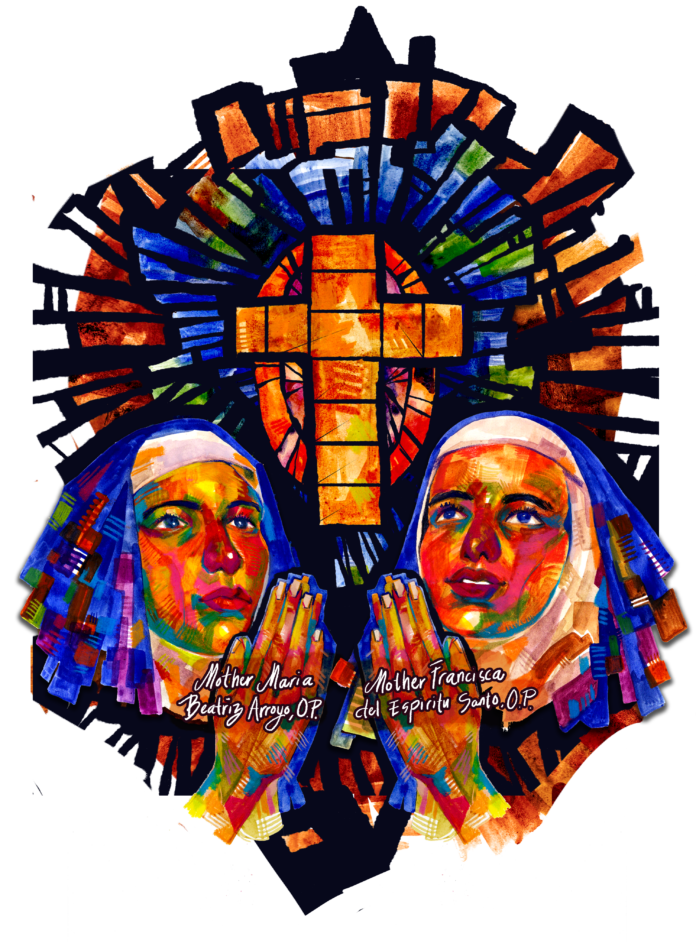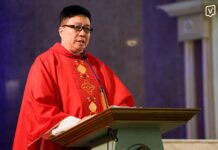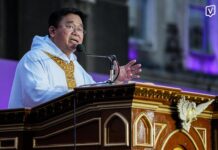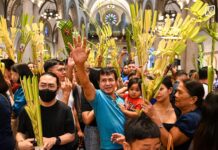THE HOLY SEE has elevated the status of two Dominican nuns from “Servant of God” to “Venerable,” advancing their causes for sainthood.
Mother Maria Beatriz del Rosario Arroyo, O.P. and Mother Francisca del Espiritu Santo, O.P. are now two steps closer to sainthood following the promulgation of the decrees by the Congregation for the Causes of Saints on June 12 and July 5.
Sr. Ma. Arlene Nacionales, O.P., secretary general of the Dominican Sisters of the Most Holy Rosary of the Philippines, said Mother Rosario lived out the heroic virtues of simplicity, charity and a life of prayer when she donated her wealth to establish their congregation in Iloilo.
“She gave up [her] wealth, even donated to the congregation, and she lived in a very simple life so that even her habit, she mended her personal own habit,” Nacionales told the Varsitarian in an interview.
Mother Rosario was born on Feb. 17, 1884, in Molo, Iloilo City.
On Jan. 3, 1914, she became a member of the Siena sisters founded by Mother Francisca in 1686.
She established the Dominican Sisters of the Most Holy Rosary of the Philippines in Iloilo City 1925.
Also known as “Madre Sayong,” Mother Rosario died of heart failure on June 14, 1957.
Former Jaro archbishop Angel Lagdameo opened the diocesan process for the cause of her canonization in 2009.
Challenge to follow heroic virtues
Sr. Cecilia Varon, O.P., superior of the Holy Rosary School of Pardo in Cebu, said Fr. Juan de Santo Domingo’s writings on the foundation of the congregation and the life of its foundress were instrumental in Mother Francisca’s cause for sainthood.
Varon added that the progress on Mother Francisca’s cause is a challenge for Siena sisters to boost the promotion of devotion to her by living out her examples.
“The first thing would be the living witnesses of the sisters. Now that she is raised to being venerable, then it’s a greater challenge for the sisters to really live her virtues,” she said.
Mother Francisca was born in Manila around 1647.
Widowed and childless, she joined the Dominican Order as a tertiary in 1682.
On July 26, 1686, she founded the Beaterio de Sta. Catalina de Sena de las Hermanas de Penitencia de la Tercera Orden and became its first prioress.
The congregation, now known as the Congregation of the Dominican Sisters of St. Catherine of Siena, was approved in 1688 by former Master of the Order Antonio Cloche.
Mother Francisca died on Aug. 24, 1711. The process for her cause for sainthood began in 2002, on the initiative of the late Manila Archbishop Jaime Cardinal Sin.
Candidates for sainthood require two miracles attributed to their intercession. On the approval of the authenticity of the first miracle, he or she is beatified or named “Blessed.” Canonization requires a second miracle.
There are currently two Filipino saints — Pedro Calungsod, canonized in 2013, and Lorenzo Ruiz de Manila, a Dominican layman, canonized in 1987.
Madre Sayong remembered for simplicity, generosity, legacy in education.
Despite being raised in an affluent family, Arroyo or Madre Sayong to her fellow religious, devoted her life and wealth to building a Dominican congregation for women and schools in Iloilo.
Sr. Ma. Arlene Nacionales, O.P., secretary general of the Dominican Sisters of the Most Holy Rosary of the Philippines, said Mother Rosario lived out the heroic virtues of simplicity, charity and a life of prayer when she donated her wealth to establish their congregation in Iloilo.
“She gave up [her] wealth, even donated to the congregation, and she lived in a very simple life so that even her habit, she mended her habit,” Nacionales told the Varsitarian in an interview.
On June 12, the Vatican’s Sacred Congregation for the Causes of Saints recognized Arroyo’s “heroic virtues,” which elevated her status from “Servant of God” to “Venerable.”
She was born on Feb. 17, 1884, in Molo, Iloilo City. She entered religious life at the old Beaterio de Santa Catalina in Manila, now known as Santa Catalina College.
As part of her formation, she took up music and taught Christian Living to children. On Jan. 3, 1914, she became a professed Dominican sister.
Madre Sayong, together with her sisters, was also sent by the bishop of Jaro to teach in the parishes to stem the spread of Protestantism.
She, along with her parents and former Jaro Bishop James Paul McCloskey, had long planned to build a religious congregation in Iloilo.
Once the permit was secured from the Vatican in 1925, Arroyo asked her superiors for help in building the religious congregation with Bishop McCloskey.
Her request was granted and she came back to Iloilo, accompanied by Mother Mercedes del Santisimo Rosario O.P. and Mother Ana de Jesus O.P.
They established the Dominican Sisters of the Most Holy Rosary of the Philippines in Iloilo City in 1925, with a charism and apostolate in education.
The congregation now has 264 professed members.
Nacionales said the Molo Sisters in Iloilo continue Mother Rosario’s legacy by expanding their network of schools in Western and Eastern Visayas, Davao del Norte, Davao Oriental, Hawaii and California.
It has ties to UST Legazpi and Elizabeth Seton School in Las Piñas and offers pastoral services in Italy.
‘No one empty-handed after an encounter with Madre Sayong’
Madre Sayong died on June 14, 1957, because of heart failure.
Several years after her death, her remains were exhumed from the Molo Catholic Cemetery and transferred to a chapel inside the Dominican Sisters Motherhouse in Molo, Iloilo City.
Her possessions were displayed in the Mother Rosario Museum inside the Motherhouse in 2008.
Mother Visitacion Alecto, head of the Mother Rosario Arroyo Commission, recalled Madre Sayong’s generosity.
“[N]obody gets inside the Mother’s house and went out [e]mpty [and] hungered,” she told the Varsitarian.
Her simple life was manifested through her possessions displayed in the museum.
Portraits of her family showed that Madre Sayong came from a family of five.
Her parents were Doña Maria Pidal and Don Ignacio Arroyo, who was a graduate of San Juan de Letran.
She had two siblings who finished their bachelor’s degree in UST. Mariano Arroyo was a physician while Jose Arroyo became a lawyer and senator.
One of their family traditions was almsgiving. In her parents’ early married life, they wanted to donate part of their wealth in support of religious foundations.
Their donation to the congregation helped build free schools for the less fortunate, such as the Sacred Heart Academy, Mary Immaculate Academy, Rosary Academy and St. Martin Academy in Iloilo.
Growing up, Madre Sayong often visited the Blessed Sacrament in their family chapel and was a devotee of the Blessed Mother. In her will, she stated that every feast of the Blessed Mother should be celebrated with a High Mass.
Madre Sayong only had two pairs of habits in observance of austerity and simplicity. The two were kept in the museum together with the habit for her burial.
“Simplicity transpired as the soul of the gallery as she only had few pairs of sandals because she only wanted to have what she needed,” Alecto said.
Venerable Madre Sayong was also described as detached from material things because “she wanted to follow the Lord, sharing with His sufferings.”
“Chastity and obedience is a part of poverty [and Mother Rosario lived up to that],” said Sr. Maria Eleanor Garlitoin, O.P., who manages the museum.
Road to sainthood
The cause for her canonization was opened by Jaro Archbishop Angel Lagdameo in 2009.
The Mother Rosario Commission then met with a postulator priest of the Augustinian Recollect Order in Rome to help them in the canonization process.
A total of 37 witnesses were interviewed to testify to Mother Rosario’s heroic virtues.
“Mother Rosario was a very charitable person. In fact, during her time, they said that nobody went out without being satisfied meeting [her] because she always gave what they need,” said Alecto.
Heroic virtues are based on the cardinal virtues, faith, hope and charity as well as the theological virtues, justice, fortitude, temperance, and prudence.
Alecto described their foundress as a prayerful woman who offered even her resting time to prayer.
“She prayed unceasingly because she prayed for everyone, not only for herself, [and] that’s heroic, that’s something,” Alecto added.
To be finally declared a saint, the Vatican must be able to validate at least two miracles attributed to the candidate — one each for beatification and canonization.
The healing miracle must be instantaneous, permanent and cannot be explained by science.
The verification of a miracle for Mother Rosario’s cause for beatification is underway.
Alecto added: “We are all called to be saints. That is our objective in living, the purpose of God in creating us. Many saints in heaven are not proclaimed, that is, not canonized, but once they are in heaven, they are saints.” M. L. Serquiña and M. U. Cotongan with reports from Therese Marie Ungson and Ma. Alena Castillo














